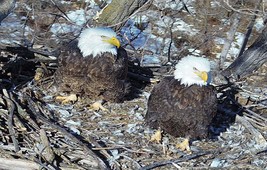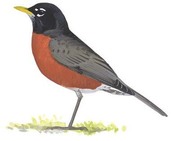|
|
|
Feb. 16, 2018
Anxiously awaiting the arrival of eggs

All of January and now Valentine’s Day have come and gone,
and still no eggs in our favorite eagles' nest.
There are many theories “flying” around about what is happening with the
famous bald couple. We hope today’s
update will help to answer some of the questions that have been coming in.
Who's your daddy?
The female at our nest is definitely the same one we’ve seen
at the nest for the last six years. She’s banded, and that band number matches what
we’ve seen here in years past. The male, however, is likely not the same bird
that has fathered our eaglets in prior years. He may not even be the same one we
saw at the beginning of the season. We just don’t know for sure, because none
of the other adult visitors to the tree have been banded. Behavior and physical
characteristics help us identify unbanded individuals, but with a lesser degree
of certainty.
“Mom” is favoring one of the male visitors and the pair has
even been spotted mating in the nest. It's rare to catch this on camera! Courtship activities, such as bringing in
sticks, rearranging them, offering food, vocalizations and feeding each other
are common nest activities we’ve witnessed.
Waiting for warmer weather?
Timing seems to be late for reproduction; it’s definitely later
than usual for this nest.
Here’s
when the first egg appeared in the previous five years we’ve been watching:
- 2017:
Jan. 28
- 2016:
Jan. 25
- 2015:
Jan. 19
- 2014:
Feb. 14
- 2013:
First week in January
With today’s temperature not expected to reach 20 degrees, the
later timing for egg arrival should be beneficial for incubation and chick
survival. Typically, eagles in Minnesota lay eggs in March, so maybe our pair
is just marching in step with other eagles in our frigid state for a change this
year!
|
|
|

Only 32 days till
Spring . . .
The recent brief spells of warm weather have many people
looking forward to spring here in the North Star State. While
the season officially arrives on March 20, for many Minnesotans, the real
arrival of spring is marked by the season’s first sighting of an American robin.
But a February robin in Minnesota is not necessarily a sign of spring at all. Often it’s just a testament to a
hearty and rugged bird that, like most of us in this state, possess the
fortitude to stand up to Old Man Winter. Bold North indeed!
Like
many other birds,
some robins will stick around all winter, as long as there’s food and adequate shelter. For the robins
that do fly south to places such as Mexico and the Caribbean, it has more to do
with easy availability of food than with cold temperatures.
Winter robins here usually hang out in sheltered areas. Unlike in spring and summer,
when their mating needs make them more territorial, they gather in large
flocks. They move around from one area to another, wherever they can find trees and shrubs still
bearing the berries and fruit that make up their winter diet. Sometimes these
berries can begin to ferment and produce alcohol that actually causes the birds
to get a little tipsy!
For the robins
that migrate, the journey
back to Minnesota will soon begin. Robins have several triggers that tell them to head north. The increasing daylight triggers
hormones that urge the
robin to establish a territory, mate and raise young. Waiting on the spring thaw and
favorable south winds, the robins
develop a restlessness
that ornithologists call zugunruhe, a German word that comes from
zug (migration) and unruhe (anxiety).
When
you first hear a robin singing,
that’s a real indicator that spring is just around the corner. Male robins sing to establish
territory and lure females for mating. Their songs,
coupled with increasing numbers of robins in the area, tell you that
warmer weather is coming soon.
March
is the robin’s peak migration month, so be on the lookout for the signs of spring. And if, in the
meantime, you start to feel a little bit of your own zugunruhe, consider getting
outside and visiting one of Minnesota’s
state parks to see what else is stirring.
|
|
|
Minnesota Nongame Wildlife Program
The EagleCam and associated technology are
paid for and maintained by the DNR’s Nongame Wildlife Program, which is largely
supported by voluntary contributions. Recognized as one of the most
successful programs of its kind in the United States, the Nongame Wildlife
program helps hundreds of Minnesota species through habitat restorations,
surveys and monitoring, technical guidance, and outreach and education –
critters such as bees, butterflies, songbirds, loons, frogs, turtles and bats,
as well as eagles. Donations to the
Nongame Wildlife Program are matched dollar for dollar by the
Reinvest in Minnesota (RIM) license plate fund. They’re also tax-deductible.
Learn more at http://www.dnr.state.mn.us/eco/nongame/index.html.
|
|